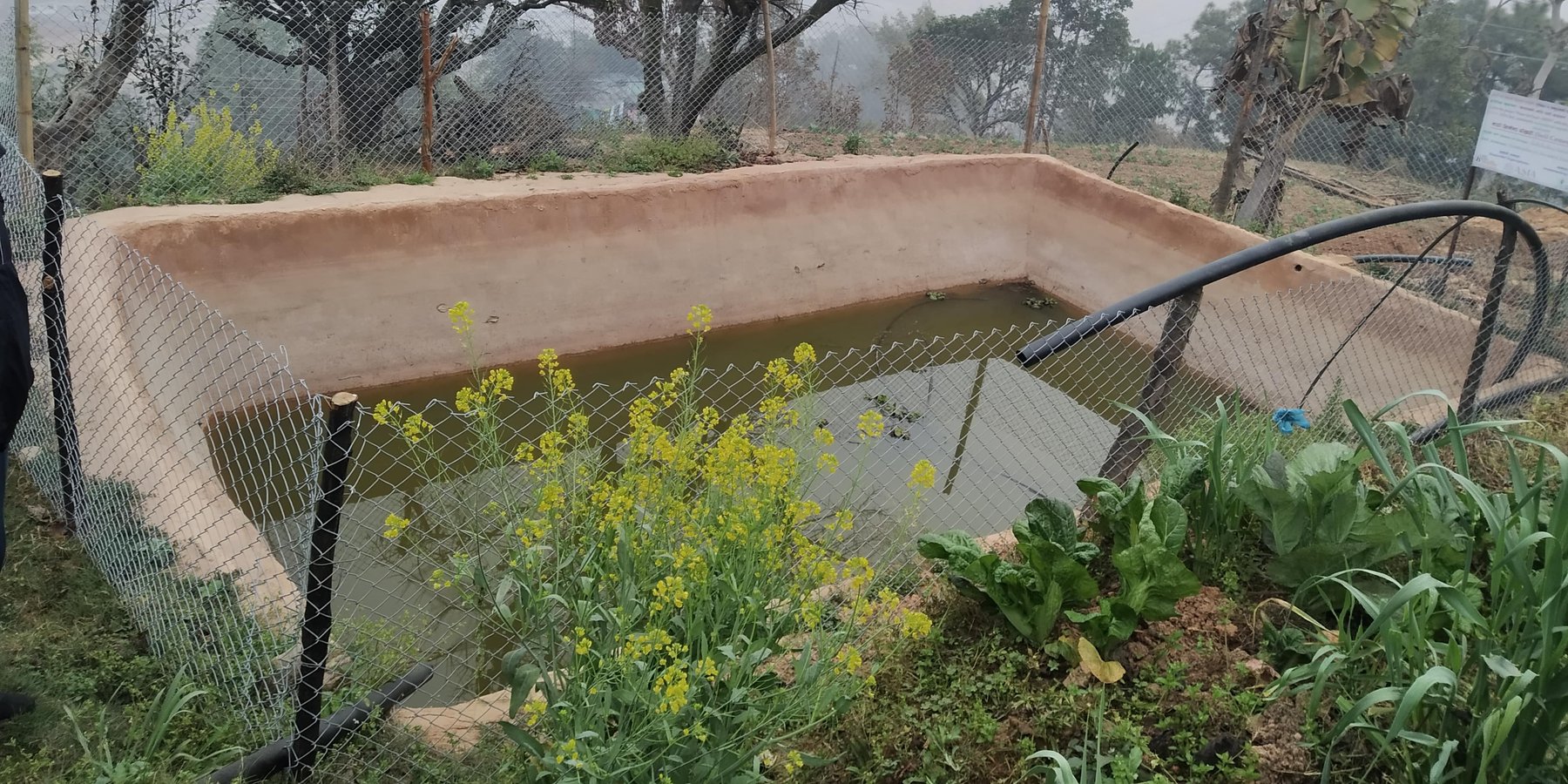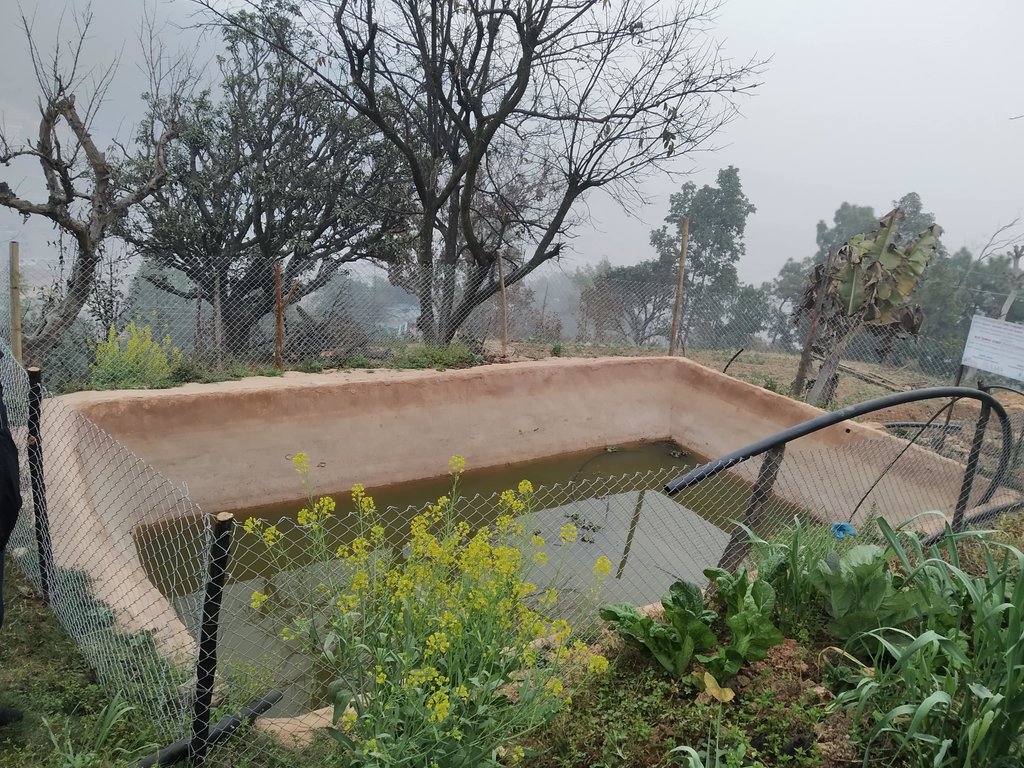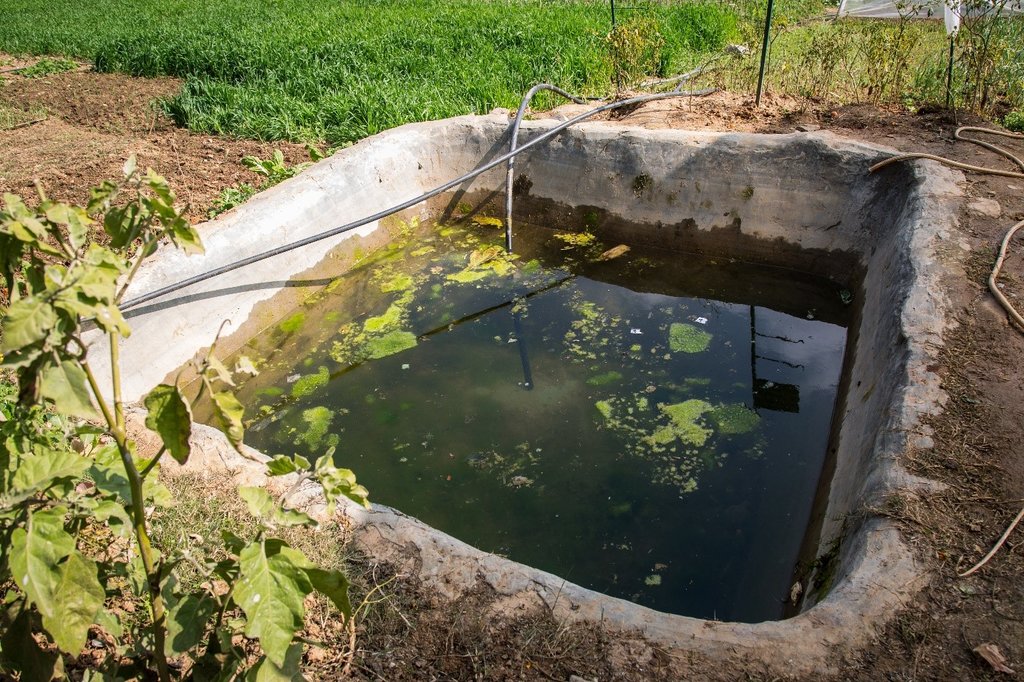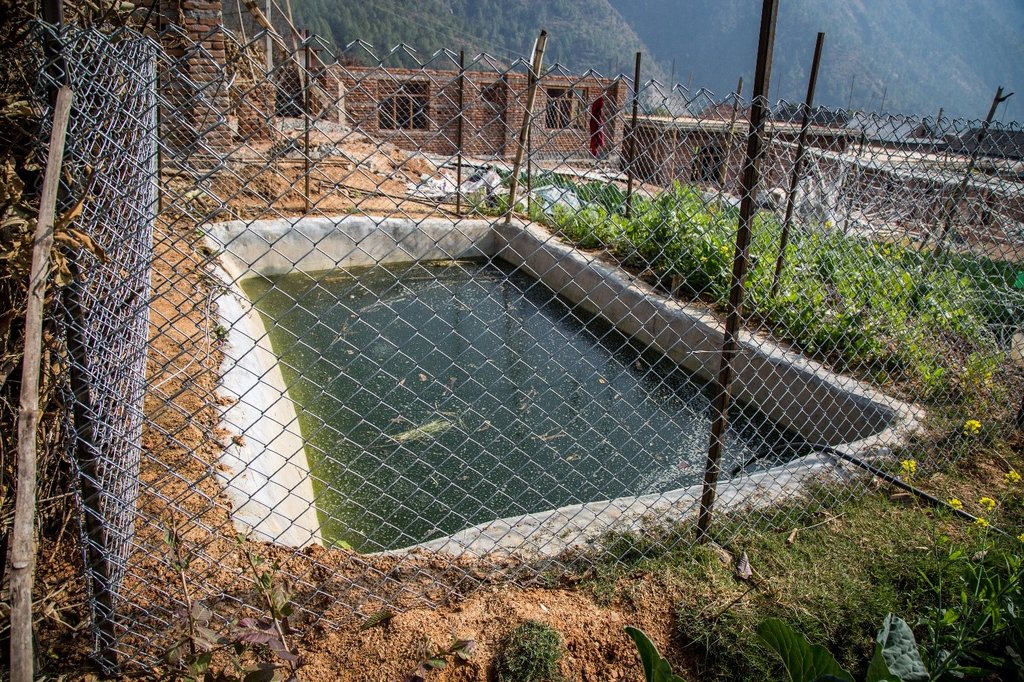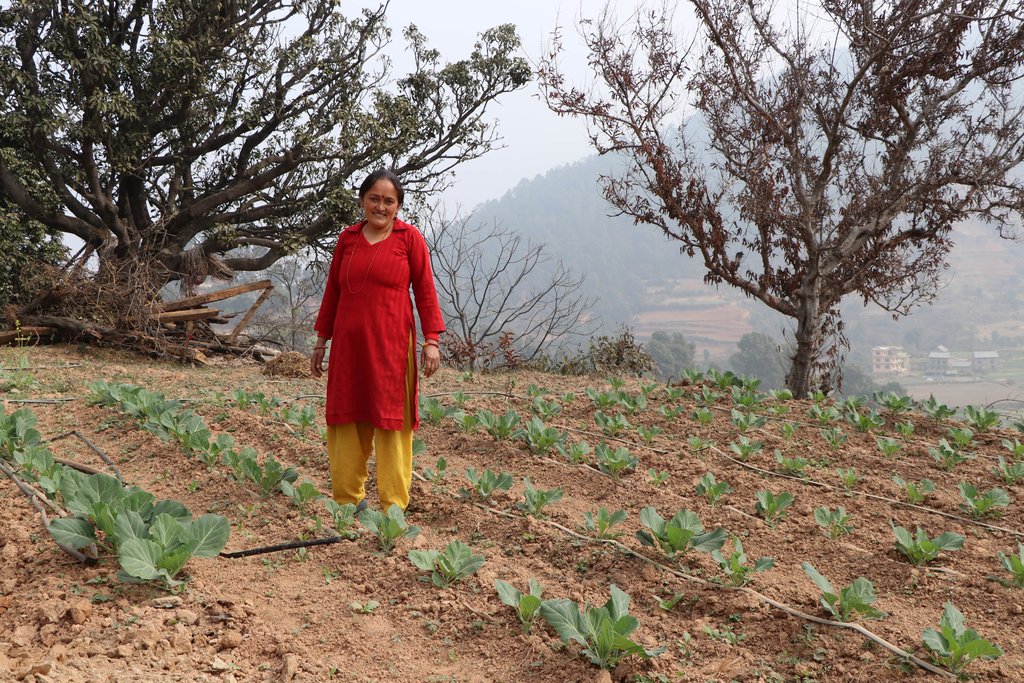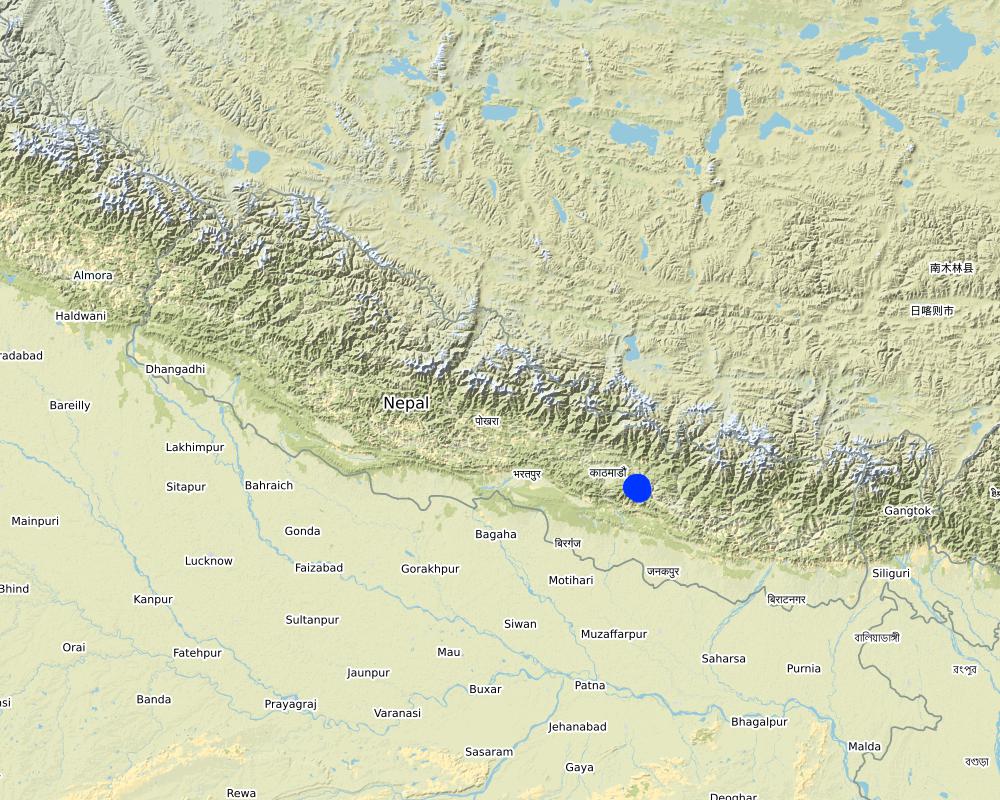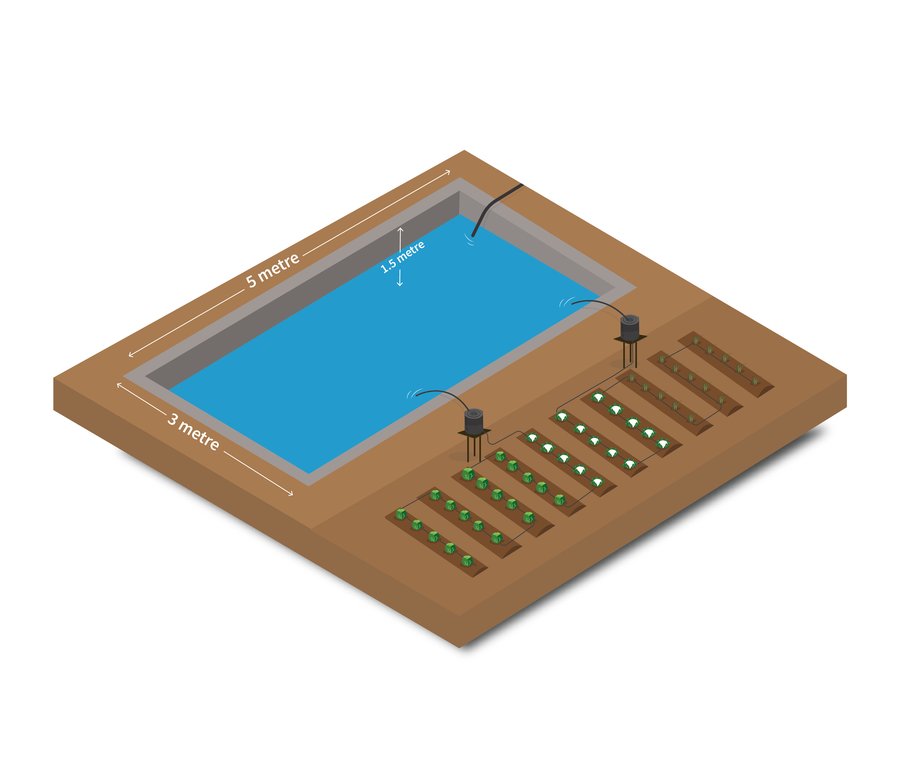Soil Cement Water Collection Pond for Supplemental Irrigation Purpose in Dry Season [Népal]
- Création :
- Mise à jour :
- Compilateur : Kabita Nhemhafuki
- Rédacteur : –
- Examinateurs : Rima Mekdaschi Studer, Isabelle Providoli
Mato, Baluwa ra Cement bata Nirmit Sinchai Pokhari - Nepali
technologies_5684 - Népal
Voir les sections
Développer tout Réduire tout1. Informations générales
1.2 Coordonnées des personnes-ressources et des institutions impliquées dans l'évaluation et la documentation de la Technologie
Personne(s)-ressource(s) clé(s)
Spécialiste GDT:
Shah Ram Deo
The Center for Environmental and Agricultural Policy Research, Extension and Development (CEAPRED)
Népal
exploitant des terres:
Gautam Laxmi
Népal
exploitant des terres:
K.C Prashuram
Népal
exploitant des terres:
Neupane Kumar
Népal
exploitant des terres:
Adhikari Apsara
Népal
exploitant des terres:
Shrestha Jay Ram
Népal
Nom du projet qui a facilité la documentation/ l'évaluation de la Technologie (si pertinent)
Resilient Mountain Solutions Initiative, ICIMOD (RMS initiative)Nom du ou des institutions qui ont facilité la documentation/ l'évaluation de la Technologie (si pertinent)
ICIMOD International Centre for Integrated Mountain Development (ICIMOD) - Népal1.3 Conditions relatives à l'utilisation par WOCAT des données documentées
Le compilateur et la(les) personne(s) ressource(s) acceptent les conditions relatives à l'utilisation par WOCAT des données documentées:
Oui
1.4 Déclaration sur la durabilité de la Technologie décrite
Est-ce que la Technologie décrite ici pose problème par rapport à la dégradation des terres, de telle sorte qu'elle ne peut pas être déclarée comme étant une technologie de gestion durable des terres?
Non
2. Description de la Technologie de GDT
2.1 Courte description de la Technologie
Définition de la Technologie:
A soil cement water collection pond to store rainwater, runoff and household kitchen waste water free from soap and detergent for supplemental irrigation purpose during dry seasons.
2.2 Description détaillée de la Technologie
Description:
In Nepal's mid-hills mountain farmers face problems during dry seasons to irrigate their fields, as they entirely depend on rain- water. Soil cement water collection pond are ideal to tackle this challenge, as they can capture excess rainfall during monsoon, which is later available during prolonged seasonal water shortage.
The Resilient Mountain Village (RMV) project of ICIMOD together with its local partner, CEAPRED tested and demonstrated soil cement ponds with a capacity of 24000 liters. The conservation ponds were used for irrigating high value off-season horticultural crops (vegetables, fruit, and spices). These crops were irrigated with drip irrigation and micro sprinklers. The ponds were fed from rainwater, upland springs and taps, and household wastewater from kitchen free from soap and detergent. They were established during the dry season during 3 months. They were prepared by selecting a suitable site with a sufficient catchment; mapping out the area and depth of the pond; digging out the soil; removing protruding stones and roots; and compacting and smoothing the sides and bottom of the pond. Then gravel and pebbles were used for the base and the floor and side walls were leveled off. Initial mixture of soil, sand and cement (3:3:1) was applied to roughly plaster all the side walls and gravel was mixed in the mixture while plastering the floor. The following day, the roughly plastered pond was watered and was covered with wet jute sack to keep it moist. This was continued for 3-4 days. Then again a second mixture of soil, sand and cement (2:2:1) was applied to smoothly plaster the floor and side walls. The pond was watered for the next 3-4 days and was covered with wet jute sacks. Around 4-5 days after the second plaster, the pond was filled with water. For safety, pond was enclosed with a gabion wire/ bamboo fence (or using any locally available material). The total establishment cost for a soil cement pond with 24000 liters capacity was USD 311.
The main maintenance activity was to maintain the gabion wire/bamboo fence to prevent livestock and people from entering the pond, and to remove the sediment that accumulates in the pond. The sediment has to be removed once a year carefully by hand and if cracks occur, it should be sealed with a mixture of soil, sand and cement (3:3:1). The total annual maintenance cost for 24000 liters soil cement tank was USD 68.
This technology has somehow helped small-land holding farmers to irrigate their rain-fed land during dry months which has increased the crop production and their income as well.
Land user's particularly liked that their production increased and that they were able to grow up to three crops per year. Trough this the farmers were able to diversify their crops, and they were less vulnerable to the dry season. In addition, soil cement water ponds are more efficient than plastic-lined conservation ponds which are easily damaged by rats. Although cost effective, the fixed price for this technology is quite high, particularly for smallholder farmers. To lessen this financial burden, local governments can provide subsidies to women and marginalized groups interested in this technology. Self-help groups with a revolving grants system would help expand the use of these ponds and ensure sustained use across Nepal.
2.3 Photos de la Technologie
Remarques générales concernant les photos:
Size of soil cement pond depends upon the area of land to be irrigated.
2.5 Pays/ région/ lieux où la Technologie a été appliquée et qui sont couverts par cette évaluation
Pays:
Népal
Région/ Etat/ Province:
Province no: 3
Autres spécifications du lieu:
Namobuddha Municipality, Kavrepalanchowk District, Nepal
Spécifiez la diffusion de la Technologie:
- appliquée en des points spécifiques ou concentrée sur une petite surface
Est-ce que les sites dans lesquels la Technologie est appliquée sont situés dans des zones protégées en permanence?
Non
Map
×2.6 Date de mise en œuvre de la Technologie
Si l'année précise est inconnue, indiquez la date approximative: :
- il y a moins de 10 ans (récemment)
2.7 Introduction de la Technologie
Spécifiez comment la Technologie a été introduite: :
- par le biais de projets/ d'interventions extérieures
Commentaires (type de projet, etc.) :
ICIMOD demonstrated this technology through the program of Resilient Mountain Village (RMV) with the help of its implementing local partner, The Center for Environmental and Agricultural Policy Research, Extension and Development (CEAPRED) in its pilot project sites in Kavrepalanchok district.
3. Classification de la Technologie de GDT
3.1 Principal(aux) objectif(s) de la Technologie
- améliorer la production
- Improve water availability during dry seasons
3.2 Type(s) actuel(s) d'utilisation des terres, là où la Technologie est appliquée
Les divers types d'utilisation des terres au sein du même unité de terrain: :
Non

Terres cultivées
- Cultures annuelles
Cultures annuelles - Précisez les cultures:
- céréales - maïs
- céréales - riz (de milieux secs)
- légumineuses et légumes secs - fèves
- plantes à racines et à tubercules - pommes de terre
- cultures de semences - sésame, moutarde, pavot, autres
- légumes - légumes à feuilles (laitues, choux, épinards, autres)
Nombre de période de croissance par an: :
- 3
Précisez:
Longest growing period in days: 150; Longest growing period from month to month: Jun - Oct; Second longest growing period in days: 120; Second longest growing period from month to month: Nov - Feb
Est-ce que les cultures intercalaires sont pratiquées?
Oui
Si oui, précisez quelles cultures sont produites en culture intercalaire:
Tomato and raddish
Est-ce que la rotation des cultures est appliquée?
Non
3.3 Est-ce que l’utilisation des terres a changé en raison de la mise en œuvre de la Technologie ?
Est-ce que l’utilisation des terres a changé en raison de la mise en œuvre de la Technologie ?
- Non (Passez à la question 3.4)
3.4 Approvisionnement en eau
Approvisionnement en eau des terres sur lesquelles est appliquée la Technologie:
- pluvial
3.5 Groupe de GDT auquel appartient la Technologie
- récupération/ collecte de l'eau
- gestion de l'irrigation (incl. l'approvisionnement en eau, le drainage)
3.6 Mesures de GDT constituant la Technologie

structures physiques
- S4: Fossés isohypses, trous
- S7: Collecte de l'eau/ approvisionnent en eau/ équipement d'irrigation
3.7 Principaux types de dégradation des terres traités par la Technologie

dégradation hydrique
- Ha: aridification
- Hs: changement de la quantité d’eau de surface
3.8 Prévention, réduction de la dégradation ou réhabilitation des terres dégradées
Spécifiez l'objectif de la Technologie au regard de la dégradation des terres:
- réduire la dégradation des terres
4. Spécifications techniques, activités, intrants et coûts de mise en œuvre
4.1 Dessin technique de la Technologie
Spécifications techniques (associées au dessin technique):
Soil Cement Water Collection Pond for Irrigation Purpose in Dry Seasons
Location: Charange fedi, 03, Namobuddha Municipality, Kavrepalanchowk
Technical knowledge required for field staff / advisors: moderate
Technical knowledge required for land users: moderate
Main technical functions: water harvesting / increase water supply
Secondary technical functions: control of dispersed runoff: retain / trap
Structural measure: pond
Depth of ditches/pits/dams (m): 1.5
Width of ditches/pits/dams (m): 3
Length of ditches/pits/dams (m): 5
Capacity of the tank= 24000 litres.
Construction material (earth): Clay
Construction material (other): Cement, sand and water-proofing liquid
Auteur:
Kabita Nhemhafuki, Ram Dev Shah
Date:
01/12/2020
4.2 Informations générales sur le calcul des intrants et des coûts
Spécifiez la manière dont les coûts et les intrants ont été calculés:
- par superficie de la Technologie
Indiquez la taille et l'unité de surface:
0.0024 ha
Si vous utilisez une unité de superficie locale, indiquez le facteur de conversion vers un hectare (p.ex. 1 ha = 2.47 acres): 1 ha = :
1 ha = 10000 square metres
Indiquez la monnaie utilisée pour le calcul des coûts:
- dollars américains
Indiquez le coût salarial moyen de la main d'œuvre par jour:
5.68
4.3 Activités de mise en place/ d'établissement
| Activité | Calendrier des activités (saisonnier) | |
|---|---|---|
| 1. | Select a preferably stable ground with a sufficient catchment area | dry months |
| 2. | Measure the area to be irrigated and estimate the size of the pond | dry months |
| 3. | Measure and mark out the pond | 1st day |
| 4. | Dig out the soil to the pre-determined depth and remove protruding stones and roots | 1st day |
| 5. | Compacting and smoothing the sides and bottom of the pond | 2nd day |
| 6. | Apply initial mixture of soil, sand, cement (3:3:1) to roughly plaster all the the side walls and mix gravel in the mixture while plastering the floor. | 2nd day |
| 7. | The following day, the roughly plastered pond should be watered and covered with wet jute sack to keep it moist. This should be continued for 3-4 days. | 3rd day |
| 8. | Apply a second mixture of soil, sand, and cement (2:2:1) to smoothly plaster the floor and side walls. | 5th day |
| 9. | Water the pond for the next 3-4 days and cover with wet jute sack. | 8th day |
| 10. | Around 4-5 days of second plaster, fill the pond with water. | 13th day |
| 11. | For safety, the pond can be enclosed with gabion wire/ bamboo fence (or using other locally available materials) | 14th day |
4.4 Coûts et intrants nécessaires à la mise en place
| Spécifiez les intrants | Unité | Quantité | Coûts par unité | Coût total par intrant | % du coût supporté par les exploitants des terres | |
|---|---|---|---|---|---|---|
| Main d'œuvre | Dig out pond | persons/unit | 7,0 | 5,68 | 39,76 | 100,0 |
| Main d'œuvre | Stone soiling | persons/unit | 1,0 | 8,74 | 8,74 | |
| Main d'œuvre | Cementing | persons/unit | 10,0 | 8,74 | 87,4 | |
| Main d'œuvre | Wiring | persons/unit | 2,0 | 8,74 | 17,48 | |
| Equipements | Spade | piece | 3,0 | 2,0 | 6,0 | 100,0 |
| Equipements | Measuring tape | piece | 2,0 | 1,0 | 2,0 | 100,0 |
| Equipements | Shovel | piece | 3,0 | 7,0 | 21,0 | 100,0 |
| Equipements | Hammer | piece | 3,0 | 4,0 | 12,0 | 100,0 |
| Equipements | Cement mixing iron pan | piece | 2,0 | 3,0 | 6,0 | 100,0 |
| Equipements | Trowel | piece | 3,0 | 2,0 | 6,0 | 100,0 |
| Matériaux de construction | Sand | bags | 24,0 | 0,87 | 20,88 | |
| Matériaux de construction | Cement | bags | 6,0 | 7,43 | 44,58 | |
| Matériaux de construction | Water proofing liquid | bottle | 1,0 | 2,62 | 2,62 | |
| Matériaux de construction | Gabion wire sheets | sq.ft | 120,0 | 0,31 | 37,2 | |
| Coût total de mise en place de la Technologie | 311,66 | |||||
| Coût total de mise en place de la Technologie en dollars américains (USD) | 311,66 | |||||
Si le coût n'est pas pris en charge à 100% par l'exploitant des terres, indiquez qui a financé le coût restant:
The Center for Environmental and Agricultural Policy Research, Extension and Development (CEAPRED) covered the remaining cost
Commentaires:
Duration of establishment phase: 3 month(s)
4.5 Activités d'entretien/ récurrentes
| Activité | Calendrier/ fréquence | |
|---|---|---|
| 1. | Maintain and repair wire fence to prevent livestock and humans from entering the pond | once in a year |
| 2. | Removing accumulated sediment once a year carefully by hand | dry months/once in a year |
4.6 Coûts et intrants nécessaires aux activités d'entretien/ récurrentes (par an)
| Spécifiez les intrants | Unité | Quantité | Coûts par unité | Coût total par intrant | % du coût supporté par les exploitants des terres | |
|---|---|---|---|---|---|---|
| Main d'œuvre | Clean and maintaining the pond | persons/unit | 3,0 | 5,68 | 17,04 | 100,0 |
| Main d'œuvre | Maintain and repair wire fence | persons/unit | 2,0 | 7,0 | 14,0 | 100,0 |
| Matériaux de construction | Gabion wire | sq.ft | 120,0 | 0,31 | 37,2 | 100,0 |
| Coût total d'entretien de la Technologie | 68,24 | |||||
| Coût total d'entretien de la Technologie en dollars américains (USD) | 68,24 | |||||
Commentaires:
The cost given above is for unit technology having 24000 liters capacity as in 2020.
4.7 Facteurs les plus importants affectant les coûts
Décrivez les facteurs les plus importants affectant les coûts :
Cost of cement and sand
Members of a household contributed as labour in all sites.
5. Environnement naturel et humain
5.1 Climat
Précipitations annuelles
- < 250 mm
- 251-500 mm
- 501-750 mm
- 751-1000 mm
- 1001-1500 mm
- 1501-2000 mm
- 2001-3000 mm
- 3001-4000 mm
- > 4000 mm
Spécifiez la pluviométrie moyenne annuelle (si connue), en mm:
1584,00
Zone agro-climatique
- humide
Thermal climate class: subtropics
5.2 Topographie
Pentes moyennes:
- plat (0-2 %)
- faible (3-5%)
- modéré (6-10%)
- onduleux (11-15%)
- vallonné (16-30%)
- raide (31-60%)
- très raide (>60%)
Reliefs:
- plateaux/ plaines
- crêtes
- flancs/ pentes de montagne
- flancs/ pentes de colline
- piémonts/ glacis (bas de pente)
- fonds de vallée/bas-fonds
Zones altitudinales:
- 0-100 m
- 101-500 m
- 501-1000 m
- 1001-1500 m
- 1501-2000 m
- 2001-2500 m
- 2501-3000 m
- 3001-4000 m
- > 4000 m
Indiquez si la Technologie est spécifiquement appliquée dans des:
- non pertinent
5.3 Sols
Profondeur moyenne du sol:
- très superficiel (0-20 cm)
- superficiel (21-50 cm)
- modérément profond (51-80 cm)
- profond (81-120 cm)
- très profond (>120 cm)
Texture du sol (de la couche arable):
- moyen (limoneux)
- fin/ lourd (argile)
Texture du sol (> 20 cm sous la surface):
- moyen (limoneux)
Matière organique de la couche arable:
- moyen (1-3%)
Si disponible, joignez une description complète du sol ou précisez les informations disponibles, par ex., type de sol, pH/ acidité du sol, capacité d'échange cationique, azote, salinité, etc.
Soil fertility is medium
Soil drainage / infiltration is good
Soil water storage capacity is medium
5.4 Disponibilité et qualité de l'eau
Profondeur estimée de l’eau dans le sol:
5-50 m
Disponibilité de l’eau de surface:
moyenne
Qualité de l’eau (non traitée):
faiblement potable (traitement nécessaire)
La qualité de l'eau fait référence à:
à la fois les eaux souterraines et de surface
La salinité de l'eau est-elle un problème? :
Non
La zone est-elle inondée?
Non
Commentaires et précisions supplémentaires sur la qualité et la quantité d'eau:
Water source is mainly spring.
More in rainy season (June- September), less in April/May; source: spring
5.5 Biodiversité
Diversité des espèces:
- élevé
Diversité des habitats:
- élevé
Commentaires et précisions supplémentaires sur la biodiversité:
Nepal harbors 3.2 % and 1.1 % world's known flora and fauna respectively despite occupying only 0.1 % of global area. Particularly, beta diversity is high in Nepal (BCN and DNPWC, 2011).
5.6 Caractéristiques des exploitants des terres appliquant la Technologie
Sédentaire ou nomade:
- Sédentaire
Orientation du système de production:
- exploitation mixte (de subsistance/ commerciale)
Revenus hors exploitation:
- 10-50% de tous les revenus
Niveau relatif de richesse:
- pauvre
- moyen
Individus ou groupes:
- individu/ ménage
Niveau de mécanisation:
- travail manuel
- traction animale
Genre:
- femmes
- hommes
Age des exploitants des terres:
- personnes d'âge moyen
Indiquez toute autre caractéristique pertinente des exploitants des terres:
Land users applying the Technology are mainly common / average land users
Population density: 154 - 453 persons per km2 ( Census, 2011)
Annual population growth : 2% - 3%
Among 100% land users, 80% of the land users are average wealthy and own 90% of the land (ranked by land users). 20% of the land users are poor and own 10% of the land.
Off-farm income specification:
Occasional opportunities for off-farm income present themselves in the form of daily labour wages.
Due to loss of farmland and increasing urbanization and loss of farmlands many people are switching from agriculture to non-farm occupations such as working in brick kilns.
The opening of the BP Highway has led to the establishment of many hotels and restaurants and the development of local market places such as Bhakundebesi.
Most local businesspersons are small entrepreneurs with limited investment capacity.
Some households’ members receive regular salaries, whilst an increasing number of Nepalis are working in India, the Middle East, Malaysia, and elsewhere and sending remittance incomes home.
Market orientation of production system: Vegetables- commercial
Level of mechanization: Manual labor consists of planting, irrigation , harvesting, while field preparation is carried out by animals, also machines but just in valley bottom.
5.7 Superficie moyenne des terres utilisées par les exploitants des terres appliquant la Technologie
- < 0,5 ha
- 0,5-1 ha
- 1-2 ha
- 2-5 ha
- 5-15 ha
- 15-50 ha
- 50-100 ha
- 100-500 ha
- 500-1 000 ha
- 1 000-10 000 ha
- > 10 000 ha
Cette superficie est-elle considérée comme de petite, moyenne ou grande dimension (en se référant au contexte local)?
- moyenne dimension
5.8 Propriété foncière, droits d’utilisation des terres et de l'eau
Propriété foncière:
- individu, avec titre de propriété
Droits d’utilisation des terres:
- individuel
Droits d’utilisation de l’eau:
- accès libre (non organisé)
- communautaire (organisé)
Est-ce que les droits d'utilisation des terres sont fondés sur un système juridique traditionnel?
Oui
5.9 Accès aux services et aux infrastructures
santé:
- pauvre
- modéré
- bonne
éducation:
- pauvre
- modéré
- bonne
assistance technique:
- pauvre
- modéré
- bonne
emploi (par ex. hors exploitation):
- pauvre
- modéré
- bonne
marchés:
- pauvre
- modéré
- bonne
énergie:
- pauvre
- modéré
- bonne
routes et transports:
- pauvre
- modéré
- bonne
eau potable et assainissement:
- pauvre
- modéré
- bonne
services financiers:
- pauvre
- modéré
- bonne
Waste management:
- pauvre
- modéré
- bonne
Commentaires:
Health facilities: There are nine health facilities centre in Namobuddha municipality, Kavre. The main health facilities are Methinkot Hospital, which is a 15-bed district level government hospital, and Dapcha Health Center, which is run by Kathmandu.
Education: There are eight academic institutes for higher studies ( higher secondary schools and colleges). The main academic institutes are:
Dapcha Krishna
Multiple Campus (community), Dapcha;
Janahit Secondary School (public), Khanalthok
Janak Multiple Campus (community), Methinkot
Janak Secondary School (public), Methinkot
Kanpur Campus(community), Kanpur and
Kanpur Secondary School
(public), Kanpur.
Employment ( off-farm): Due to loss of farmlands and increasing urbanization, many people are switching from agriculture to non-farm occupations such as working in brick kilns. The opening of the BP Highway has led to the establishment of many hotels and restaurants and the development of local market places such as Bhakundebesi. Most local businesspersons are small entrepreneurs with limited investment capacity.
Market: Bhakundebesi is the emerging marketplace due to its strategic location in the middle of the municipality astrid the BP Highway. Most local business activities in the municipality take place in Bhakundebesi bazaar. It is a major place for local people to purchase consumer goods.
Energy
Cooking fuel:
In 2011, 88% of households mainly used firewood for cooking, followed by liquefied petroleum gas (LPG) (4.92%). In Puranogaun Dapcha, almost all households (99.8%) relied on firewood for cooking. LPG was relatively popular in Dapcha Chatrebhanjh (10.3%) and Khanalthok (11.5%). Less than 6% of households used biogas for cooking, with its use relatively high in Mathurapati Fulbari (19.3%) and Methinkot (15.9%) (CBS, 2011).
Lighting :
93% of households used electricity for lighting while 5% depended on kerosene. Dependency on kerosene was relatively high in Khanalthok (8.1%) and Methinkot (7.4%). There was little solar lighting except for in Khanalthok where 3% of households relied on it (CBS, 2011).
Roads and Transportation:
Namobuddha Municipality is easily accessible by motorable road from neighboring areas via the BP Highway, which splits the municipality into almost two equal halves . The highway, which runs from Banepa to Bardibas in the Terai, is the shortest route from the Kathmandu Valley to the eastern hills and Terai. The limited width of the road and its sharp bends mean that public transportation along the BP Highway is mostly by small buses and jeeps.
Drinking water and Sanitation:
In 2011, about 60% of households had access to taps or piped water with accessibility varying across the municipality. While about 80% of PuranogauDapcha households had taps or piped water, only 37.5% of households in Simalchour Syampati enjoyed such services. Other sources of drinking water were covered wells (12.3%), uncovered wells (20.2%) and water spouts (6.3%). Methinkot (40.8%) and Simalchour Syampati (31.4%) residents were most reliant on uncovered wells. Covered wells served sizeable household populations in Dapcha Chatrebhanjh (35.3%) and Simalchour Syampati (23%) (CBS, 2011).
Toilet facilities: In 2011, about 63% of households had accessto toilet facilities, with about 40% overall having flushtoilets. The least toilet coverage was in Kanpur Kalapaniand Simalchour Syampati VDCs where 63% and 58% ofhouseholds respectively did not have their own toilets. Almost all households in Puranogaun Dapcha had their own toilets, mostly flush toilets (CBS, 2011).
Waste Management: – Namobuddha is in the early phase of urbanization with no systematic waste management.The Municipality Office is searching for a landfill site.
6. Impacts et conclusions
6.1 Impacts sur site que la Technologie a montrés
Impacts socio-économiques
Production
production agricole
Commentaires/ spécifiez:
Before they used to plant only one crop per year but now due to adoption of this technology, crop production has increased as they plant three crops per year.
qualité des cultures
Commentaires/ spécifiez:
Crop quality has become good due to availability of more water for irrigation and integration of this technology with bio-pesticide jholmol and mulching.
surface de production
Commentaires/ spécifiez:
Due to availability of water for irrigation, farmers have turned many fallow land into agricultural land.
Disponibilité et qualité de l'eau
disponibilité de l'eau d'irrigation
Commentaires/ spécifiez:
Water needed for irrigation has increased as all the waste water from households, rainwater and taps waters are stored in this tank for irrigation in dry seasons.
Revenus et coûts
revenus agricoles
Commentaires/ spécifiez:
Irrigation water availability has increased crop production in turn farmer income has increased by selling those crops in market.
Impacts socioculturels
sécurité alimentaire/ autosuffisance
Commentaires/ spécifiez:
Farmers are becoming more self sufficient due to high production of crops.
institutions communautaires
Commentaires/ spécifiez:
Due to informal network of farmers with pond has strengthened community institutions.
connaissances sur la GDT/ dégradation des terres
Commentaires/ spécifiez:
Farmers share their knowledge and experiences with each other and discuss on how they can overcome the challenges they have been facing recently.
Impacts écologiques
Sols
humidité du sol
Commentaires/ spécifiez:
Due to availability of more irrigation water.
couverture du sol
Commentaires/ spécifiez:
Most of the fallow land are turned into crop land.
6.2 Impacts hors site que la Technologie a montrés
inondations en aval
Commentaires/ spécifiez:
Due to trapped runoff
6.3 Exposition et sensibilité de la Technologie aux changements progressifs et aux évènements extrêmes/catastrophes liés au climat (telles que perçues par les exploitants des terres)
Changements climatiques progressifs
Changements climatiques progressifs
| Saison | Augmentation ou diminution | Comment la Technologie fait-elle face à cela? | |
|---|---|---|---|
| températures annuelles | augmente | pas connu |
Extrêmes climatiques (catastrophes)
Catastrophes météorologiques
| Comment la Technologie fait-elle face à cela? | |
|---|---|
| pluie torrentielle locale | bien |
| tempête de vent locale | bien |
Catastrophes climatiques
| Comment la Technologie fait-elle face à cela? | |
|---|---|
| sécheresse | modérément |
Catastrophes hydrologiques
| Comment la Technologie fait-elle face à cela? | |
|---|---|
| inondation générale (rivière) | pas bien |
Autres extrêmes climatiques (catastrophes)
| autre (précisez) | Comment la Technologie fait-elle face à cela? |
|---|---|
| reducing growing period | bien |
6.4 Analyse coûts-bénéfices
Quels sont les bénéfices comparativement aux coûts de mise en place (du point de vue des exploitants des terres)?
Rentabilité à court terme:
positive
Rentabilité à long terme:
très positive
Quels sont les bénéfices comparativement aux coûts d'entretien récurrents (du point de vue des exploitants des terres)?
Rentabilité à court terme:
très positive
Rentabilité à long terme:
très positive
6.5 Adoption de la Technologie
- > 50%
De tous ceux qui ont adopté la Technologie, combien d'entre eux l'ont fait spontanément, à savoir sans recevoir aucune incitation matérielle, ou aucune rémunération? :
- 11-50%
Commentaires:
Till now 24 land user families of Namobuddha Municipality have adopted this technology.
Among 24 land user families, 18 have adopted this technology with external material support through Resilient Mountain Village (RMV) project and 6 land users families have adopted this technology without any external support.
Comments on spontaneous adoption (Through survey results) : There is no trend towards spontaneous adoption of the technology because this technology is quiet expensive, compared to plastic- lined conservation pond.
6.6 Adaptation
La Technologie a-t-elle été récemment modifiée pour s'adapter à l'évolution des conditions?
Non
6.7 Points forts/ avantages/ possibilités de la Technologie
| Points forts/ avantages/ possibilités du point de vue de l'exploitant des terres |
|---|
| Water stored in this tank is sufficient to irrigate 2-3 ropani (1 ropani = 508 sq.m.) land in one season. |
| This technology can be enhanced by sharing the advantages of this technology with large number of people. |
| It is more sustainable and efficient than plastic-lined conservation pond. |
| Points forts/ avantages/ possibilités du point de vue du compilateur ou d'une autre personne ressource clé |
|---|
| Good income can be achieved even from a small piece of land by sales of vegetables in the dry season . |
| These ponds are fed with rainwater and household kitchen wastewater free from soap and detergent and from springs and taps. The pond water was mainly used for micro irrigation including drip irrigation and micro-sprinkler. |
| It helps to promote the use of other water conserving techniques like mulching when using the harvested water. |
| It has reduced the dependence on large scale water supply schemes. |
| How can they be sustained / enhanced? Harvest all possible sources of water. |
6.8 Faiblesses/ inconvénients/ risques de la Technologie et moyens de les surmonter
| Faiblesses/ inconvénients/ risques du point de vue de l’exploitant des terres | Comment peuvent-ils être surmontés? |
|---|---|
| Soil cement tank is expensive for poor farmers. | Subsidized cost for poor farmers. |
| It is unsafe for small children. | Protection structures should be constructed. |
| Faiblesses/ inconvénients/ risques du point de vue du compilateur ou d'une autre personne ressource clé | Comment peuvent-ils être surmontés? |
|---|---|
| Cement and sand rate is very expensive for poor farmers. | Make it available in the local market at a subsidized cost for poor farmers. |
| The ponds attract insects, mainly mosquitoes, that cause disease; and the ponds are unsafe for small children. | Regularly clean the pond and fence them. |
7. Références et liens
7.1 Méthodes/ sources d'information
- visites de terrain, enquêtes sur le terrain
6
- interviews/entretiens avec les exploitants des terres
5
- interviews/ entretiens avec les spécialistes/ experts de GDT
1
- compilation à partir de rapports et d'autres documents existants
2
Quand les données ont-elles été compilées (sur le terrain)?
20/02/2020
7.2 Références des publications disponibles
Titre, auteur, année, ISBN:
ICIMOD (2018) Building Mountain Resilience: Solutions from the Hindu Kush Himalaya. Kathmandu: ICIMOD
Disponible à partir d'où? Coût?
ICIMOD
Titre, auteur, année, ISBN:
SCWMC (2004) Soil Conservation and Watershed Management Measures and Low Cost Techniques. Kathmandu: Government of Nepal, Soil Conservation and Watershed Management Component - Department of Soil Conservation and Watershed Management
Disponible à partir d'où? Coût?
DSCWM, Kathmandu
7.3 Liens vers les informations pertinentes en ligne
Titre/ description:
Namobuddha Municipality, Nepal Situation Analysis for Green Municipal Development, 2018
URL:
https://gggi.org/site/assets/uploads/2018/07/GGGI_GMD-Assessment_Namobuddha.pdf
Titre/ description:
Farmers in Kavre reaping benefits from soil cement tanks, 2021
URL:
https://www.icimod.org/article/farmers-in-kavre-reaping-the-benefits-of-soil-cement-tanks/
Liens et modules
Développer tout Réduire toutLiens
Aucun lien
Modules
Aucun module trouvé


